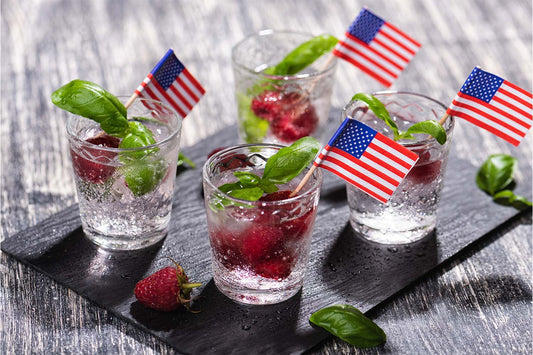Aperol is everywhere, seemingly overnight. The sunset red-orange aperitif has gained instant recognition and popularity, and people tend to either love its unique flavor or hate it.
If you’re not a huge fan of the liquor but want to try something similar when making drinks at home, we have a few creative Aperol substitutes for you!
Aperol Basics
Before you decide which of the Aperol substitutes is the best fit for your needs, we want you to have a little background on what it is you’re replacing.
Unfortunately, unlike many alcohols out there, Aperol’s real ingredient list and recipe is a closely guarded secret. According to the company that owns and distributes Aperol, that secret recipe has been the same since its inception in 1919. Since then, we’ve received a few bits and pieces from the ingredient list but will likely never know them in their entirety.
From what we know, Aperol is made from a combination of key ingredients, including bitter and sweet oranges, different herbs and roots, and rhubarb. However, the bitter flavor is the one that lingers the longest on the palate, which is why the aperitif is not for everyone. It’s not an exaggeration to call it a unique flavor, and it is a large part of the aperitif culture in Italy.
Popular Aperol Recipes
There are many ways that people enjoy Aperol, but the most popular is the Aperol Spritz. The drink was even dubbed the “drink of the summer” a few years ago, likely because of its refreshing nature and relatively low ABV.
The Aperol Spritz
To make an Aperol Spritz, you’ll need a white wine glass, Aperol, soda water, Prosecco, ice, and an orange. Fill the glass with ice, add three parts Prosecco, followed by two parts Aperol. To that, add just a splash of soda water and garnish it with an orange slice. No mixing, shaking, or stirring is required.
The Paper Plane
While the Aperol Spritz is by far the most famous, there is another Aperol cocktail that people tend to gravitate towards — the Paper Plane.
Created in 2008 by a bartender named Sam Ross in New York City, the Paper Plane is a take on a class cocktail called the Last Word. However, it is also much higher in alcohol content than aperitifs (and especially the Aperol Spritz).
The drink includes equal parts (¾ ounce each) of bourbon, Aperol, Amaro Nonino Quintessentia (an herbaceous, bitter liquor from Italy), and freshly squeezed lemon juice. The ingredients are shaken together and served without ice in a coupe glass.
Ok, But What Is an Aperitif?
The word aperitif gets thrown around a lot, but not many people really understand what it means.
The first and most important thing to understand about aperitifs is that it is not a “type” of alcohol, per se. At least, not in the same way we talk about whiskeys or tequilas.
While all aperitifs are alcohols, not all alcohols are aperitifs. Instead, the term aperitif refers to a purpose instead of shared physical characteristics — they are meant to be enjoyed before a meal.
In fact, it can help to think of aperitifs as a liquid appetizer. You should drink them before dining, and they are meant to be sipped instead of slammed. Much like appetizers are supposed to “open up” a meal by whetting your appetite and getting you excited to eat, aperitifs are meant to open up a conversation and get it flowing more naturally.
While the concept of the aperitif started in Europe, it has slowly been gaining more and more popularity in the United States. While it seems to have started with Aperol, it’s expanded into a more adult way of drinking that fits better into how people live these days.
The Best Aperol Substitutes
The best Aperol substitutes consider what your plan for Aperol would have been in the first place. There aren’t many direct replacements for Aperol’s uniquely bitter flavor, but there are plenty of aperitifs that can be used in a Spritz without significantly raising the ABV.
For many people, the flavor profile of Aperol is very similar to Campari (another bitter, red-orange liquor). However, if this is a switch you are thinking of making, be aware that Campari is much higher in alcohol content. Campari also tends to be a little bit more bitter than Aperol, so it may be too extreme for many people’s palates.
A better option is switching Aperol out for another aperitif with a similar flavor profile but not quite as bitter. Our New Fashioned is an excellent Aperol substitute in this regard, as it is complex, spiced, and a little bitter (thanks to the inclusion of cloves on the ingredient list). This drink can be enjoyed just as easily on the rocks as it can in Spritz form.
Another close substitute for Aperol is Lillet. Although this aperitif is French instead of Italian, Lillet also makes an excellent, complex Spritz. It isn’t as extremely flavored as Aperol (existing somewhere in the middle of bitter and sweet), but it comes in Blanc (white), Rosé, and Rouge (red) options, so you have even more customization potential.
What Pairs Well With Aperol (And Aperol Substitutes)?
Although Aperol (and other aperitifs) are meant to be enjoyed on their own and in the company of close friends, there are a few foods that pair well with them if you decide to go that route.
Aperol comes from Italy, and Italy is well known for its small plates (you may have heard them called “tapas” or “cicchetti.”). Together, drinks meant to be sipped and food meant to be eaten without formality create the perfect environment for relaxation and enjoyment without pressure.
Examples of some of the most popular finger foods to serve alongside your Aperol Spritzes (or Aperol substitutes) include:
- Crostini with olive tapenade
- Polpette (miniature meatballs)
- Arancini (rice/risotto balls)
- Tramezzini (tiny triangular sandwiches)
However, if you’re really trying to keep things simple, you don’t need to go all out and make appetizers!
You can go the sweet snacking route, if you prefer, and combine a less bitter aperitif (like Citrus Flower with a splash of prosecco) with a selection of dried fruits and chocolate. Remember, aperitif culture is more about enjoying your time with your loved ones, so you don’t need to serve an entire meal! If you’re inviting over health-conscious guests, you can even do fresh fruits and dark chocolate (which is better for you!).
Nuts also make an excellent snack to pair with more bitter drinks, especially spiced nuts. You don’t want to go in too much of the opposite direction, as the difference between the flavors can be too extreme. Just make sure no one in your group has a nut allergy!
How Can You Align More With Aperitif Culture?
Aperitifs are more than just a drink; they’re an entire way of life in Europe. If you’ve ever been privileged enough to travel through Europe, especially countries like Italy and France, you’ll see that the culture there places a lot of value on a slower pace. Meals are extended out for hours and are more about fostering a sense of community and enjoying life than about the food itself (although it is delicious!).
When you align yourself more with the idea of aperitif culture, it’s a way to practice a greater sense of mindfulness in your life. Instead of worrying about the things that may happen in the future or focusing on the problems of the past, you’re forced to exist in the moment. Living this way takes practice, doing the conscious work of stopping those thoughts and living in the now.
Try this — the next time you have friends over, don’t plan a huge event. Instead, invite over just a handful of your closest friends (the friends you feel like you can really be yourself around). Put on some light background music, light a fire, and pour them a glass of aperitif (if they have different taste preferences, check out our Deluxe Cocktail Kit that has six of our best sellers).
Then, start a conversation! Talk about life, your goals, the world — anything you want. The point is the connection and not the subject matter.
It’s amazing how little time and space we actually give ourselves to connect. We focus so much time and attention on getting ahead, so slowing down and spending time with ourselves and the people we care about can be a life-altering experience. Life moves fast enough; take some time to enjoy it before it passes you by.
In Conclusion
Haus focuses our entire brand on aperitif culture. We believe the entire idea of slowing down and remembering to appreciate the small things and important people is crucial, especially in today’s go go go society. You should enjoy your drinks the same way, sipping them slowly and enjoying them without worrying about dealing with a hangover the following day!
Sources:
How Much Alcohol Is in My Drink? | Live Science
Dark Chocolate | The Nutrition Source | Harvard TH Chan School of Public Health




